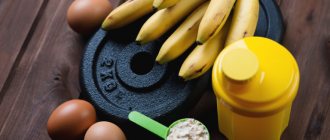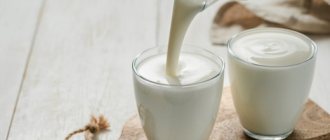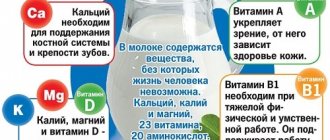Do you think it is possible to drink milk after a workout, will it be beneficial? On the one hand, the drink is rich in vitamins, micro and macroelements, contains protein and easily digestible carbohydrates. On the other hand, about half of the population of our planet suffers from milk intolerance. Nutritionists classify the product as “heavy” in terms of digestibility, and also note its ability to promote the accumulation of fats.
So, is it possible to drink milk before or after a workout, or is it better to abandon this product in favor of any protein shake? The answer to this question will not be clear. If you love milk, and your body easily absorbs its components, you can not only drink it, but you should! If the thought of drinking a drink makes you feel sick, and if you forcefully pour it in, intestinal upsets often occur, give up this idea. In the end, milk can be replaced with sour milk, cottage cheese or white cheese.
Milk[edit | edit code]
Dairy products as a source of protein
Milk
has long been considered one of the best means for building muscle mass in bodybuilding. However, some athletes are allergic to lactose (the sugar in milk) or have a lack or absence of enzymes in their bodies that digest it. In this case, drink kefir, yogurt, eat cottage cheese and cheese, i.e. those dairy products from which lactose has been removed during industrial processing. By consuming them, you can get the same effect as from 2-3 liters of milk per day. You can also purchase lactase tablets at pharmacies, an enzyme that breaks down lactose, and take them with milk. If you have no problems digesting milk, then give preference (if possible) to fresh, raw milk instead of pasteurized milk. It is advisable to do this also because the modern dairy industry is far from ideal and the milk that is sold in stores can be saturated with various harmful additives, and this will not have the best effect on your health.
By the way, if milk enters the stomach along with other foods at the same time, then there are much fewer problems with lactose intolerance. Therefore, try to wash down your regular meals with 1-2 glasses of milk during the stage of gaining muscle mass. This way it will be better absorbed, and as you gain weight, things will be much more fun.
Milk for bodybuilders has another beneficial property. The fact is that high-calorie nutrition leads to increased secretion of all anabolic hormones, including insulin. The danger is that insulin will certainly convert some of the carbohydrates eaten into subcutaneous fat. This is due to its natural function - to create emergency fuel reserves in the body. So, milk blocks this function of insulin. If you drink it while gaining muscle mass, you will accumulate less fat!
In a study conducted in 2022[1] It has been shown that high milk consumption can reduce life expectancy by increasing oxidative processes in cells.
Milk production and processing[edit | edit code]
The industry produces pasteurized and sterilized milk. Pasteurization
, simply put, is heating milk. Thus, under the influence of high temperature, harmful microorganisms that may be in it are destroyed (though not all of them), and the shelf life of milk increases. True, heating does not go unnoticed for many bioactive substances that are useful and important for health. Under the influence of high temperature they are destroyed.
Sterilization
- This is a deep heat treatment of milk, when it is heated to a temperature of 130-140 degrees. No germs can survive here! The shelf life of sterilized milk is calculated in months, but there is very little benefit in such milk. It can be compared to ordinary water in which several tablespoons of powdered milk are dissolved. There are no living factors in it by definition.
The best milk, of course, if you can get it, is fresh milk. If you start spicing up your strength training with liters of fresh milk, you will immediately notice an increase in muscle mass and strength. In addition, you will increase the level of the so-called. “general health”, without which strength and other sports records cannot be achieved.
What is the secret of fresh milk? As science has established, it contains “live” immunoglobulins that enhance immunity, natural antitoxins, as well as very special compounds called cytokines. By the way, the same cytokines are also produced in the human body. They perform a variety of tasks in our body, but one of them is truly unique. They interfere with the genetic apparatus of stem cells, causing them to degenerate into muscle cells.
As is known, stem cells are formed in the bone marrow and do not have their own “face”. Together with the blood, they “travel” throughout the body and, if necessary, turn into cells of certain tissues of the body.
When you exercise, muscle cell fibers tear. Their healing occurs under the influence of stem cells, which in turn are controlled by cytokines.
Boiling destroys most of the cytokines in milk. When you drink fresh milk, cytokines increase in your body, and therefore muscle growth accelerates.
Currently, science has described several dozen cytokines, but it is impossible to accurately determine the function of each. The role of cytokines is universal. They often replace each other or act together. However, American scientists have achieved the incredible. From colostrum, the secretion of the mammalian mammary gland that is formed in the first postpartum weeks, they isolated cytokines that stimulate protein synthesis. It is the presence of these cytokines that explains the uniquely rapid growth of infants, in whose body, of course, there are no anabolic hormones. If such cytokines are introduced into the body, where the process of muscle growth, triggered by physical exercise, is already underway, we will get a fantastic increase in muscle mass. The use of cytokines on rats led to an increase in their physical size almost doubling!
It is curious that the research was initiated by the head of the famous Scott Connelly solely in the interests of bodybuilders. The drug, called Pro-genex, is about to enter the human trial stage. As Connelly promises, he will close the steroid era in our sport, but will lead to the birth of previously unheard of monsters of muscle mass.
When it comes to the quality of milk and dairy products, if you have a choice, go for goat milk. In all its indicators, it overlaps with cow's milk and is absorbed much better.
| TABLE OF MACRONUTRIENT CONTENTS IN MAIN DAIRY PRODUCTS AND RECOMMENDATIONS CONCERNING THEIR USE | ||
| PRODUCT TYPE | COMPOSITION OF MACRONUTRIENTS | HOW TO USE |
| Whole milk (250 g) | 146 cal, 8 g protein, 11 g carbs, 8 g fat | Occasionally; before and after training by adding whey protein |
| Low-fat milk 2% (250 g) | 122 cal, 8 g protein, 11 g carbs, 5 g fat | Before and after training, adding whey protein; After your workout, add some chocolate syrup as well. |
| Low fat milk 1% (250 g) | 102 cal, 8 g protein, 11 g carbohydrates, 2 g fat | Before and after training, adding whey protein; After your workout, add some chocolate syrup as well. |
| Skim milk 0% (250 g) | 83 cal, 8 g protein, 11 g carbohydrates, 0 g fat | Before and after training, adding whey protein; After your workout, add some chocolate syrup as well. |
| Cheddar cheese (1 slice) | 113 cal, 7 g protein, 0 g carbs, 9 g fat | Rarely |
| Low fat Cheddar cheese (1 slice) | 49 cal, 7 g protein, 1 g carbs, 2 g fat | Add to scrambled eggs, salad or sandwich for a protein boost |
| Parmesan cheese (1 slice) | 121 cal, 11 g protein, 1 g carbs, 8 g fat | Rarely |
| Homemade cheese (1 slice) | 232 cal, 28 g protein, 6 g carbs, 10 g fat | Before bedtime |
| Low-fat homemade cheese (1 slice) | 163 cal, 28 g protein, 6 g carbs, 2 g fat | Before bedtime |
| Low-fat cottage cheese (1 slice) | 123 cal, 25 g protein, 3 g carbohydrates, 1 g fat | Before and after training as a source of casein; before bedtime |
| Low fat natural yogurt | 143 cal, 12 g protein, 16 g carbs, 4 g fat | As a separate meal (add whey protein); to increase protein content in the diet |
| Low-fat natural yogurt | 127 cal, 13 g protein, 17 g carbs, 0 g fat | As a separate meal (add whey protein); to increase protein content in the diet |
| Low fat fruit yogurt | 225 cal, 9 g protein, 42 g carbs, 3 g fat | To increase carbohydrate intake (add whey protein) |
| Low-fat fruit yogurt | 213 cal, 10 g protein, 43 g carbs, 0 g fat | Post-workout to increase carbohydrate intake (add whey protein) |
Example of a dairy diet
- 1 meal (pp.): 5-10 egg whites;
- oatmeal;
- cottage cheese or cheese +1-3 tsp. linseed oil;
- 2 p.p.: buckwheat or rice porridge;
- 1-2 glasses of low-fat milk.
- 3 p.p. before training: buckwheat or rice porridge with raisins and honey (1-3 tsp);
- 1-2 glasses of low-fat milk.
- 4 p.p. after training: buckwheat or rice porridge with raisins and honey (1-3 tsp);
- 2-4 slices of whole grain bread;
- 1-2 glasses of low-fat milk.
- 5 pp: rice with honey (1-3 tsp);
- 1-2 glasses of low-fat milk.
- 6 p.p. before bed: 1-2 glasses of kefir + cottage cheese or cheese if desired.
Total per day (depending on the size of the portions): Cal - 3000-3600, proteins - 150-200 g, carbohydrates - 450-550 g, fats - 30-50 g.
In the 2022 study. Scientists have proven that eating cheese does not affect cholesterol levels.[2]
White rice
White rice is considered to be the rice grain that has been peeled. The benefits of this type of rice are questionable, since it is devoid of essential nutrients. In the shell, which is removed during the production of white rice, beneficial vitamins (group B, , nicotinic acid, biotin) and minerals (potassium, calcium, magnesium, copper, phosphorus, iron, iodine, sodium) remain. In the polished grain itself, carbohydrates (starch, fiber), proteins (except gluten) and fats in small quantities remain. Since there are few vitamins and minerals left in it, you should not expect to compensate for the deficiency of these compounds from eating white rice dishes.
Soaked white rice gives a good effect for fitness enthusiasts. During the soaking process, the starch is washed out of it, resulting in a reduction in calorie content. The fiber remaining in it absorbs waste and toxic substances from the intestines, and due to the high potassium content, rice removes water from the body well.
The best option for those on a special diet while doing fitness is to eat red, black or wild rice rather than white.
Additional information from Muscle and Fitness #3[edit | edit code]
Bodybuilding is on the verge of creating a monstrously POWERFUL anabolic steroid!
VINCE ANDRICH
There were times when milk replaced the current sports nutrition for security forces. It was considered a powerful stimulant of muscle strength. Having heard about this, an adherent of modern and, to be honest, completely “chemically chemicalized” bodybuilding, will only smile condescendingly. In fact, what does simple cow's milk have to do with extreme sports records? Does milk help build muscle?
It would seem that there is none. However, there are several disconcerting inconsistencies in this matter. The strength records of that era, when methane was replaced by several liters of fresh milk per day and a couple of juicy chops, have not yet been broken. Comparing the life expectancy of strength athletes will not be in our favor either. George Hackenschmidt happily lived to the age of 89, and Armand Tunney attended bodybuilding competitions with interest at the age of 90. What ; In our "pharmacological" era, the main concern of competitive bodybuilders is to obtain free health insurance from their national federations. The list of diseases that 40-year-old athletes suffer from will surprise anyone. There is everything here, from unusually early heart attacks to oncology.
However, let's get back to milk. We must immediately make a reservation that we are talking about the kind of milk that you won’t find on supermarket shelves today - fresh milk, the same one that they say “fresh from the cow”...
Two sides of the same coin[edit | edit code]
Strongmen from the beginning of the last century unanimously insisted that fresh milk was a magical panacea for an athlete. The doctors echoed them. In those years, they prescribed this milk to many patients as medicine. However, this product never found its application in bodybuilding of the 20th century. The reason is that bodybuilders, remembering the instructions of the security forces at the beginning of the century, began to drink... boiled milk.
Here it is necessary to clarify that in industrial production, when milk is repeatedly poured from one container to another during the processing process, it becomes saturated with microbes that provoke souring and can even become hazardous to health. Pasteurization of milk, in other words, boiling it, kills microbes, and therefore pasteurized milk is stored longer than fresh milk. The difference is even more noticeable if you store boiled milk in the refrigerator. However, heating does not go unnoticed for many bioactive substances. Under the influence of high temperature they are destroyed.
Yet pasteurized milk remains healthy. At one time, British scientists alone, commissioned by the government, conducted over 300 large-scale studies of the effects of milk on the human body. Officials suspected that animal cholesterol, which is high in milk, was harmful to heart health. It turned out that cholesterol from milk does not increase blood cholesterol levels, no matter how much milk you drink. Moreover, regular consumption of pasteurized milk significantly reduces the risk of cardiovascular disease. In any case, the statistics of heart attacks among those who drank a lot of milk was significantly reduced. Scientists were also surprised by the fact that among active milk consumers there were fewer cases of intestinal cancer.
Pasteurization does almost no harm to milk proteins, namely whey and casein. In pasteurized milk, both types of protein retain the same natural ratio as in fresh milk, equal to 20:80. At the same time, the proteins act synergistically and improve mutual absorption. That is why after training, whey should be taken together with “slow” casein. Contrary to expectations, “long-lasting” casein does not slow down, but rather accelerates the absorption of key amino acids that affect protein synthesis in muscles.
Friendship of the Antipodes[edit | edit code]
Whey is a water-soluble protein that is uniquely high in branched chain amino acids. They are designated by the English abbreviation BCAA. These amino acids include leucine, valine and isoleucine. By coincidence, BCAAs are the most abundant amino acids in human muscle protein. Moreover, the most important is leucine. Strength training stimulates the growth of intracellular protein (protein synthesis), but the “key” that unlocks the cell towards this fundamental reaction is leucine molecules.
The powerful release of leucine into the blood, which occurs after taking whey powder, rapidly accelerates protein synthesis. Let us repeat, leucine itself is not an anabolic steroid. This is what he becomes after heavy strength training. For this reason, taking whey powder is mandatory immediately after training with iron. This protein “doping” accelerates muscle growth by an order of magnitude! Moreover, the serum should also be taken 15-30 minutes before training. This will further enhance its anabolic effect!
Whey protein is the champion in speed of absorption. So, protein synthesis triggered by leucine immediately receives abundant building material in the form of a wide range of amino acids. It would seem that there is no reason to mix “fast” whey with “slow” casein. However, casein, sticking together in the intestines into stubborn lumps, releases not only individual amino acids, but also peptides - compounds of 2-3 amino acids. Such peptides have the properties of independent bioactive compounds. In particular, among them there are casokinins, which increase the unique ability of blood cells to “squeeze” through capillaries that are much narrower than their transverse diameter. Whey also has these kinds of peptides (lactokinins). The combined intake of whey and casein multiplies this effect and leads to increased capillary blood flow. It is clear that all this further enhances protein synthesis in the deep layers of muscle tissue.
However, pasteurized milk is far from a true anabolic. Unless you first stir a scoop of whey into a glass of milk.
Live milk and...[edit | edit code]
Pasteurized milk should not be confused with sterilized milk. As you already know, heating milk during pasteurization is not destructive for all types of microorganisms. Sterilization is a deep heat treatment of milk, when it is heated to a temperature of 130-140 degrees. No germs can survive here! The shelf life of sterilized milk is calculated in months, but there is very little benefit in such milk. It can be compared to ordinary water in which several tablespoons of powdered milk are dissolved. There are no living factors in it by definition.
But if you start seasoning your strength training with liters of fresh milk, you will immediately notice an acceleration in the growth of muscle mass and strength. In addition, you will increase the level of the so-called. “general health”, without which strength and other sports records cannot be achieved.
The pace of evolution[edit | edit code]
What is the secret of fresh milk? As science has established, it contains “live” immunoglobulins that enhance immunity, natural antitoxins, as well as very special compounds called cytokines. By the way, the same cytokines are also produced in the human body. They perform a variety of tasks in our body, but one of them is truly unique. They interfere with the genetic apparatus of stem cells, causing them to degenerate into muscle cells.
As is known, stem cells are formed in the bone marrow and do not have their own “face”. Together with the blood, they “travel” throughout the body and, if necessary, turn into cells of certain tissues of the body.
When you exercise, muscle cell fibers tear. Their healing occurs under the influence of stem cells, which in turn are controlled by cytokines. Boiling destroys most of the cytokines in milk. When you drink fresh milk, cytokines increase in your body, and therefore muscle growth accelerates.
Currently, science has described several dozen cytokines, but it is impossible to accurately determine the function of each. The role of cytokines is universal. They often replace each other or act together. However, American scientists have achieved the incredible. From colostrum, the secretion of the mammalian mammary gland that is formed in the first postpartum weeks, they isolated cytokines that stimulate protein synthesis. It is the presence of these cytokines that explains the uniquely rapid growth of infants, in whose body, of course, there are no anabolic hormones. If such cytokines are introduced into the body, where the process of muscle growth, triggered by physical exercise, is already underway, we will get a fantastic increase in muscle mass. The use of cytokines on rats led to an increase in their physical size, almost doubling!
Meanwhile, even with the purest content of a cow, one milliliter of fresh milk contains about 100,000 bacteria, of which putrefactive bacteria account for approximately 96%, and fermented milk only 4%. In this regard, you should drink milk directly from under the cow undesirable. It is much more useful to wait for the product to “ripen”, that is, to stand for 6-8 hours, or even better – a day. During this time, the ratio of putrefactive and lactic acid microflora changes: 4% putrefactive and 96% lactic acid bacteria. In addition, it is necessary to remember that fresh milk is a common cause of severe infection - brucellosis!
It is curious that the research was initiated by the head of the famous Scott Connelly solely in the interests of bodybuilders. The drug, called Progenex, is about to enter human trials. As Connelly promises, he will close the steroid era in our sport, but will lead to the birth of previously unheard of monsters of muscle mass.
HEALTH NEWS:
ALL ABOUT SPORTS
Sprains during training: what vitamins will help strengthen muscles and ligaments?
SPORTAuthor: admin4October 29, 2020
Pain during training arises not only from honestly performed work, but also due to various injuries. The most common of these are muscle and ligament sprains. If such seemingly frivolous damage occurs too often, this is a serious cause for concern. After all, as you know, where it is thin, it breaks.
Read more
Reasons to play sports: top 5. Train before it's too late
SPORTAuthor: admin4 September 28, 2018
Things at work, household chores, social networks - all this mercilessly devours our free time. Even going to the gym after 30 years is not easy. At the same time, banal exercises with dumbbells no longer suit you and you want something more. What are the main reasons to play sports? Where can I get the motivation to sign up for a swimming class, martial arts class, or just play…
Read more
ABOUT HEALTH
Exercises that burn the most calories. Speeding up the weight loss process
Weight loss Author: admin4 September 21, 2021
Exercises that burn the most calories will help you quickly get into excellent shape and maintain it. Their list is very diverse and allows lovers of both aerobic and anaerobic exercise to make a choice. However, the optimal combination is cardio and strength training, which allows you to lose weight and form a beautiful muscle profile.
Read more
What to remove from your diet to lose weight
Weight loss Author: admin4 June 30, 2021
What to remove from your diet to lose weight?
This question is asked by millions of people around the world. Diets scare us by having to give up our favorite foods. But are the prohibitions really so categorical? It turns out that if you approach this topic in an organized manner, armed with the necessary knowledge in advance, then proper nutrition will not bring much discomfort. In addition, those who want to lose weight today have special… Read more
Milk in bodybuilding[edit | edit code]
- In 1899, strongman Bernard Manfadden began publishing a magazine dedicated to weight training. In 1923, he published an article in which he called fresh milk an elixir of strength.
- In the 1930s, strength athlete Joseph Hise promoted fresh milk as a staple in an athlete's diet. In just a month, he gained over 12 kg of lean muscle by doing squats alone. At the same time, he drank up to 5 liters of fresh milk per day. “In the late 30s, the milk relay was picked up by Olympic weightlifting champion John Grimek. Thanks to his numerous interviews, fresh milk became a mandatory product in the diet of bodybuilders of that time.
- In 1950, Mr. USA Armand Tani announced that his secret weapon in the fight for the title was countless liters of fresh milk. "In 1954, Mr. Universe Steve Reeves began acting in films. Giving interviews to the press, he never forgot to emphasize the benefits of fresh milk and called for its widespread use.
- In 1958, 10-time Mr. Universe Per Park surprised the bodybuilding world by announcing that he had been eating more than four times a day for many years. Moreover, 6 times a day he drank a special milkshake based on fresh milk, to which he added cream and honey.
- Powerlifter Bruce Randall, planning to set a new national record, decided to lift his body weight. As a result, he “got heavier” to 181 kg, drinking 3-4 liters of fresh milk a day. It is curious that while maintaining a dairy diet, Randal “lost weight” to 101 kg and in 1959 won the title “Mr. Universe”.
- From the 50s to the end of the 80s, Vine Gironda enjoyed a reputation as the best coach of stars in the United States. Unaware of the latest research on whey protein, He put his clients on homemade cottage cheese. His diet program for weight gain included, in addition to 3 meals, 4 more snacks in the form of a large glass of fresh milk and a bowl of Homemade cottage cheese.
- In 1962, Larry Scott, who drank a lot of fresh milk following his teacher Gironda, used his own title of "Mr. America" to promote the benefits of whole dairy products.
- In 1977, Arnold Schwarzenegger described how much fresh milk the bodybuilders of the “golden era” of bodybuilding drank in his book “The Making of a Bodybuilder.”
Fast food
For people who are in love with fitness, there are a number of definitely harmful products that are generally undesirable to consume. This is, first of all, any fast food. This includes:
- street food (white pasties, pasties, hot dogs, pies, puff pastries, buns);
- bistro dishes (grilled chicken, french fries, shawarma, hamburgers, pizza, meatballs);
- various frozen semi-finished products intended for heating or quick preparation (cutlets, zrazy, cabbage rolls, stuffed peppers, dumplings, dumplings, khinkali);
- breakfast cereals (chips, snacks, cereals, nuts, crackers).
Fast food is food with a lot of fat, “fast” carbohydrates and salt. The fats contained in such products are most often dangerous trans fats, the consumption of even small amounts of which is harmful to human health, since it impairs the functioning of the heart and blood vessels, contributes to obesity and disruption of metabolic processes in the body.
Fast food is also rich in preservatives, flavor enhancers, flavorings and other food additives. The main food additive in fast food dishes is monosodium glutamate (E621). The crushed raw materials used for the production of fast foods contain practically no vitamins and few minerals needed by the body (except for table salt). The absence or minimal amount of fresh vegetables in these dishes is fraught with a deficiency of fiber necessary for normal digestion.
For people who are keen on fitness, they should absolutely forget about fast food and instant products. To stay in shape, such people need to eat healthy protein-containing animal products, such as rabbit, skinless chicken or turkey breast, fish, and seafood. In this case, you should cook them yourself by boiling, baking or steaming.
MILK RULES[edit | edit code]
American scientists, finding out the undoubted benefits of sports carbohydrate drinks, like Gatorade, compared its effect with various popular drinks, including whole chocolate milk. To their surprise, this milk turned out to be more effective in restoring the athlete’s strength. This experience was retested in England. And then it was confirmed that adding cocoa powder to whole milk actually speeds up recovery, outpacing the performance of Gatorade.
American scientists also report that whole milk has a better effect on protein synthesis in muscles than skim milk. If you're thinking of using high-fat chocolate milk to boost muscle growth, add a scoop of whey to make sure.
Carbonated drinks
Carbonation of soft drinks and mineral waters is carried out with carbon dioxide. Carbon dioxide itself is a preservative, acidity regulator and antioxidant (E290). Carbon dioxide is an absolutely unstable compound that quickly breaks down to form water and carbon dioxide. Despite the harmlessness of carbon dioxide in the environment, carbon dioxide in the human body exhibits a number of undesirable effects:
- causes bloating;
- increases the acidity of gastric juice, which irritates the gastric mucosa;
- makes it difficult to digest food in the intestines;
- disrupts the peristalsis of the stomach and intestines, causing reflux of gastric contents into the esophagus and dyskinetic diarrhea;
- flushes calcium salts from the body;
- destroys tooth enamel.
In addition to these effects of the E290 food additive, the scientific literature also contains information about the stone-forming effect of carbon dioxide on the urinary system.
To avoid exposing the body to unnecessary harmful effects of carbon dioxide, fans of various types of physical activity should avoid carbonated drinks altogether. We are talking not only about sweet sodas, but also about mineral water.
Only pure still water has a positive effect on metabolism. Mineral waters are not products of everyday consumption, so their drinking should also be limited to 0.5 liters per day, regardless of whether they are carbonated or not.
Low alcohol content alcohol
Best materials of the month
- Coronaviruses: SARS-CoV-2 (COVID-19)
- Antibiotics for the prevention and treatment of COVID-19: how effective are they?
- The most common "office" diseases
- Does vodka kill coronavirus?
- How to stay alive on our roads?
Fitness lovers need to not only change their entire diet, giving preference to healthy foods, but also give up alcohol. They are not required to completely give up alcohol, but they should drink it in moderation and no more than once or twice a month.
The harmful effects of low-alcohol drinks (cocktails, low-alcohol drinks, beer) on the body should not be underestimated. Despite the low ethanol content in them, this alcohol is very high in calories, as it contains sugar, yeast, hops, and all kinds of flavoring and aromatic additives. Moreover, it is better to drink a couple of glasses of high-quality strong alcohol at the table than to be satisfied with several bottles of “weak” alcohol. However, we should not forget that pure vodka, although similar in transparency to water, also contains a lot of calories: 100 g of 40° vodka is 230 kcal!











